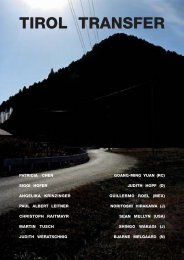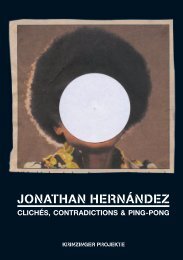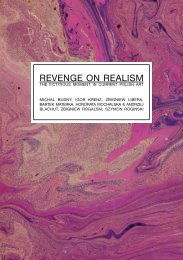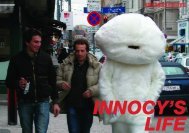post_modellismus – models in art - krinzinger projekte - Galerie ...
post_modellismus – models in art - krinzinger projekte - Galerie ...
post_modellismus – models in art - krinzinger projekte - Galerie ...
Create successful ePaper yourself
Turn your PDF publications into a flip-book with our unique Google optimized e-Paper software.
which the ambiguous temporal structure<br />
of the <strong>models</strong> becomes <strong>in</strong>scribed <strong>in</strong> the<br />
pictures. In the mise-en-scenes we encounter<br />
someth<strong>in</strong>g temporally unique, not<br />
an <strong>in</strong>sight <strong>in</strong>to past, really exist<strong>in</strong>g worlds<br />
are given, but a glimpse of someth<strong>in</strong>g only<br />
seem<strong>in</strong>gly exist<strong>in</strong>g, is shot, which is still<br />
<strong>in</strong>vented and thus utopian. Time appears<br />
<strong>in</strong> the picture by way of a false present,<br />
as a visualization of the model problem<br />
and a narrative of the impossibility of<br />
visualiz<strong>in</strong>g someth<strong>in</strong>g <strong>in</strong> the present.<br />
The works by Sab<strong>in</strong>e Hornig and Michal<br />
Budny as well as Christoph Raitmayr can<br />
be seen as a connection of these two strategies.<br />
Here no temporal structures, but<br />
rather the <strong>models</strong> themselves are doubled.<br />
Various <strong>models</strong> (types or dimensions)<br />
are compared, standards and degrees<br />
of fiction juxtaposed. Hornig, for<br />
<strong>in</strong>stance, comb<strong>in</strong>es a photograph of a bus<br />
stop with a m<strong>in</strong>imalist object depict<strong>in</strong>g<br />
of it, so that it rema<strong>in</strong>s open which variant<br />
is the orig<strong>in</strong>al and which the model.<br />
Christoph Raitmayr, <strong>in</strong> turn, places a villa<br />
from the 1920s/1930s on a coffee table of<br />
a bare domestic landscape.<br />
A further strategy can be found <strong>in</strong> the work<br />
by Stefan Wischnewski and Kyrill Koval.<br />
They use the category of the readymade.<br />
Wischnewski places backpacks and<br />
carryalls next to his MTSV sofa to form an<br />
everyday sitt<strong>in</strong>g sculpture just as one often<br />
f<strong>in</strong>ds at tra<strong>in</strong> stations and <strong>in</strong> front of hotels<br />
when unions and clubs travel as groups.<br />
Kyrill Koval builds a podium, which visitors<br />
can climb up, it is a world that is otherwise<br />
hidden, for it is a false ceil<strong>in</strong>g which<br />
is used <strong>in</strong> concrete build<strong>in</strong>gs to hide supply<br />
l<strong>in</strong>es. Lutz/Guggisberg shows a bookshelf<br />
with fictive book titles and book<br />
mock-ups. Hans Ulrich Obrist’s approach<br />
to the model character of <strong>art</strong> is presented<br />
with his Do-It anthology. Ready-mades are<br />
ord<strong>in</strong>ary objects that have been <strong>art</strong>istically<br />
declared to be <strong>art</strong>works. Their re<strong>in</strong>terpretation<br />
create an ord<strong>in</strong>ary good to valuable,<br />
unique objects does not necessarily<br />
turn them <strong>in</strong>to <strong>models</strong>. However, <strong>in</strong> <strong>art</strong> history,<br />
the readymade became a model for<br />
<strong>art</strong> itself, for modern <strong>art</strong> <strong>in</strong> p<strong>art</strong>icular. The<br />
readymade, actually a prototype, became<br />
a model of an epoch, which dealt with<br />
<strong>models</strong> itself. The ‘f<strong>in</strong>ished product’ was<br />
used to demonstrate how a reproduction<br />
could become an orig<strong>in</strong>al. From today’s<br />
perspective, this is less <strong>in</strong>terest<strong>in</strong>g as an<br />
act of <strong>in</strong>terpretation than as a question<br />
as to whether this enhanced value could<br />
not be reversed aga<strong>in</strong>, i.e., the orig<strong>in</strong>al<br />
could once aga<strong>in</strong> become a functional<br />
object, someth<strong>in</strong>g special could once<br />
aga<strong>in</strong> become someth<strong>in</strong>g familiar, someth<strong>in</strong>g<br />
taken entirely for granted.<br />
There can be no doubt. All of the objects<br />
<strong>in</strong> the exhibition demonstrate how much<br />
<strong>models</strong> can become <strong>art</strong>works and vice<br />
versa. Models are prelim<strong>in</strong>ary, theoretical<br />
and if they are used as evidence then only<br />
<strong>in</strong> quotation marks. They are props, prelim<strong>in</strong>ary<br />
studies and pauses for reflection<br />
which themselves are up for debate. The<br />
exhibition makes use of precisely this aspect.<br />
In the <strong>post</strong>_<strong>models</strong>, which come<br />
after (<strong>in</strong> a dual sense) someth<strong>in</strong>g else, the<br />
undecided nature is <strong>in</strong> the foreground.<br />
Instead of the question as to authenticity<br />
the question as to the orig<strong>in</strong>al is posed,<br />
and question of added value yields to the<br />
question of ought and be<strong>in</strong>g. Their hypothetical<br />
be<strong>in</strong>g allows for the open-endedness<br />
so typical of theses <strong>models</strong>, the<br />
means to exist between someth<strong>in</strong>g very<br />
familiar and someth<strong>in</strong>g disconcert<strong>in</strong>g<br />
and the free occupation of the space<br />
between <strong>post</strong> and modelism.<br />
27









